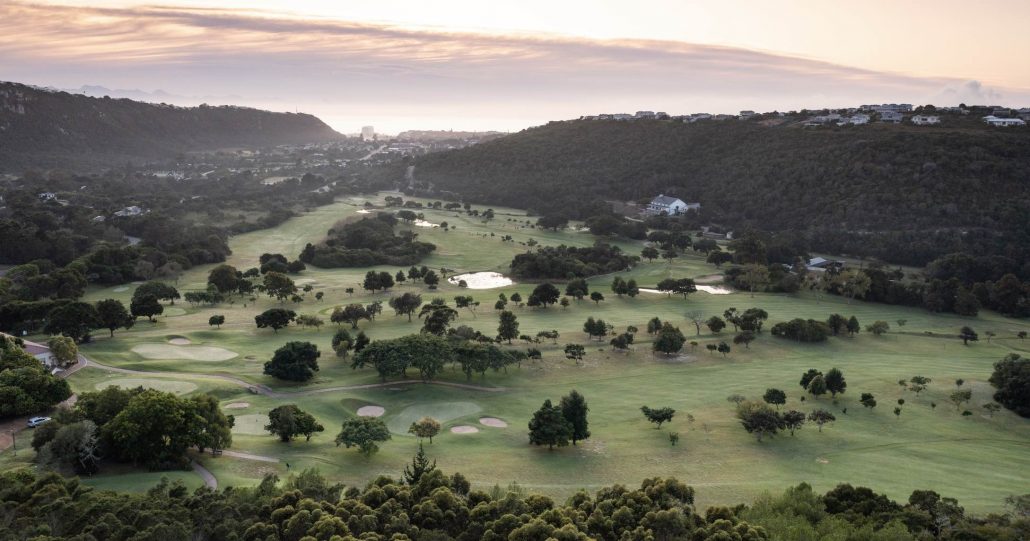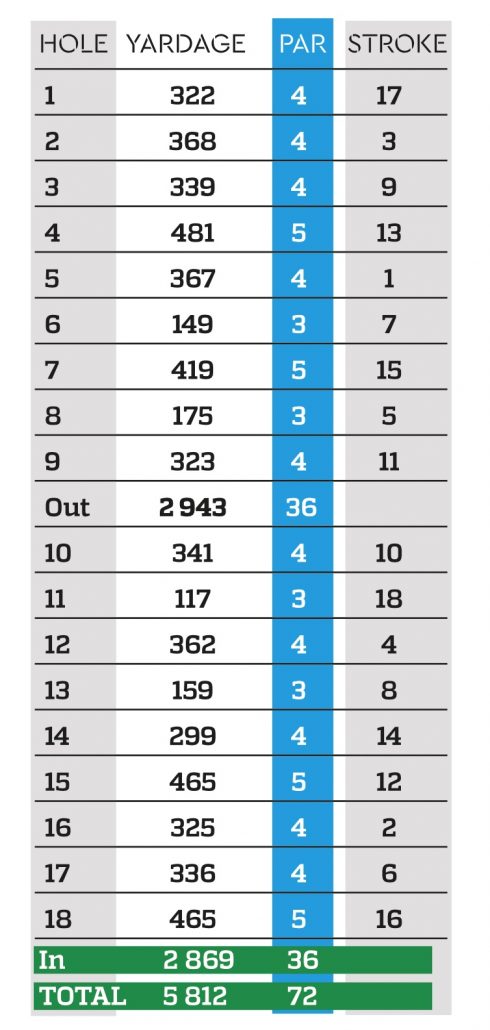Of all the courses along the Garden Route, Plettenberg Bay CC should be high up on your must-play list, writes MARK SAMPSON.
Plettenberg Bay has always held an allure for travellers across South Africa and further afield.
A coastal town set beside the Keurbooms River lagoon on the one side and the majestic Robberg Nature Reserve jutting into the Indian Ocean on the opposite side, and with several beautiful beaches in between, it truly is a spectacular destination. Venturing inland to the Knysna forest and Harkerville area the diversity of the area is hard to beat.
A lesser-known river of the Plettenberg Bay precinct is the Piesang River which is known to have been a docking area for passing ships as early as 1630. The river was navigable for quite a way up and this produced a hub of activity and business within the valley area, making it one of the earliest developments in what was to become Plettenberg Bay.
Near to the head of the valley, set within the confines of a pristine private nature reserve, you will find Plettenberg Bay Country Club.
Due to the very nature of the area, the course is a delight to play with its mature indigenous trees, abundant birdlife and the odd small antelope.
Although ‘Plett’, as it is locally referred to, is supposedly a haven for some of the country’s rich and famous, the club has an unpretentious, friendly atmosphere. The clubhouse, which is undergoing upgrades, envelopes a patio area overlooking the 18th green. The patio, being the main hub of activity, is surrounded by the bar and dining area, halfway house and pro shop.
The course was designed by Fred Hawtree and opened in 1977, after the original nine-hole layout had to move due to a development taking over the land.
The original layout stood untouched until 2001 when Rob O’Friell, who had previously been involved with The River Club and Royal Johannesburg, was brought in to improve the greens and make some aesthetic changes including introducing numerous bridges to the course.
The greens were upgraded to USGA specifications, greatly enhancing playability and status of the course. In 2018 the bunkers were upgraded, primarily to improve drainage.
Along with the clubhouse development, several new initiatives are on the go under the watchful eye of the general manager, Tyler Chislett, who was appointed in July 2022.
Having honed his skills at Zimbali Country Club for a number of years he moved on to Durban Country Club for a change of scenery. Soon thereafter, however, he was appointed as general manager of Plett Country Club.
He has brought in two specialised teams from the Matko Group, the Peter Matkovich architectural and maintenance company, who are tasked with a variety of projects, including upgrading the entire irrigation system to make it more efficient and reducing water usage. A number of small areas on the greens have become contaminated with POA grass over the years and a two-year project is underway to eradicate it from the course entirely.
Finally, the team, along with environmental specialists Eco Route, are reducing alien vegetation and upgrading the waterways to align the course with international environmental standards and enhance the nature reserve.
The two nines are very different in look and playability.
The front nine is questionably the easier as it is flatter and lies in what would be referred to as an open parkland area. It has very few large trees, but numerous water hazards are in play and most greens are very well bunkered.
The bent grass greens really are a treat to putt on. Although not massive they are well contoured with very few flat lies.
The back nine meanders through coastal forest and large encroaching indigenous trees, the soul of the valley. With the openness of the front nine forgotten, any errant tee shot will most likely require a provisional ball, bearing in mind the bush is reputed to have a very healthy snake population.
Large yellowwood trees, which have primarily been cut down throughout the region for furniture, are plentiful. Knysna loeries, or turacos as they are now named, are also common sightings with their blood-red underwings and white eye shadow.
Numerous holes are noteworthy. The first par five is the 4th hole, playing a hefty 481m. With heavy reeds both sides of the fairway and water right and crossing the front of the green, it can be treacherous. If the easterly wind is up, the stroke-13 rating can be ignored. The green also has some severe contouring towards the front.
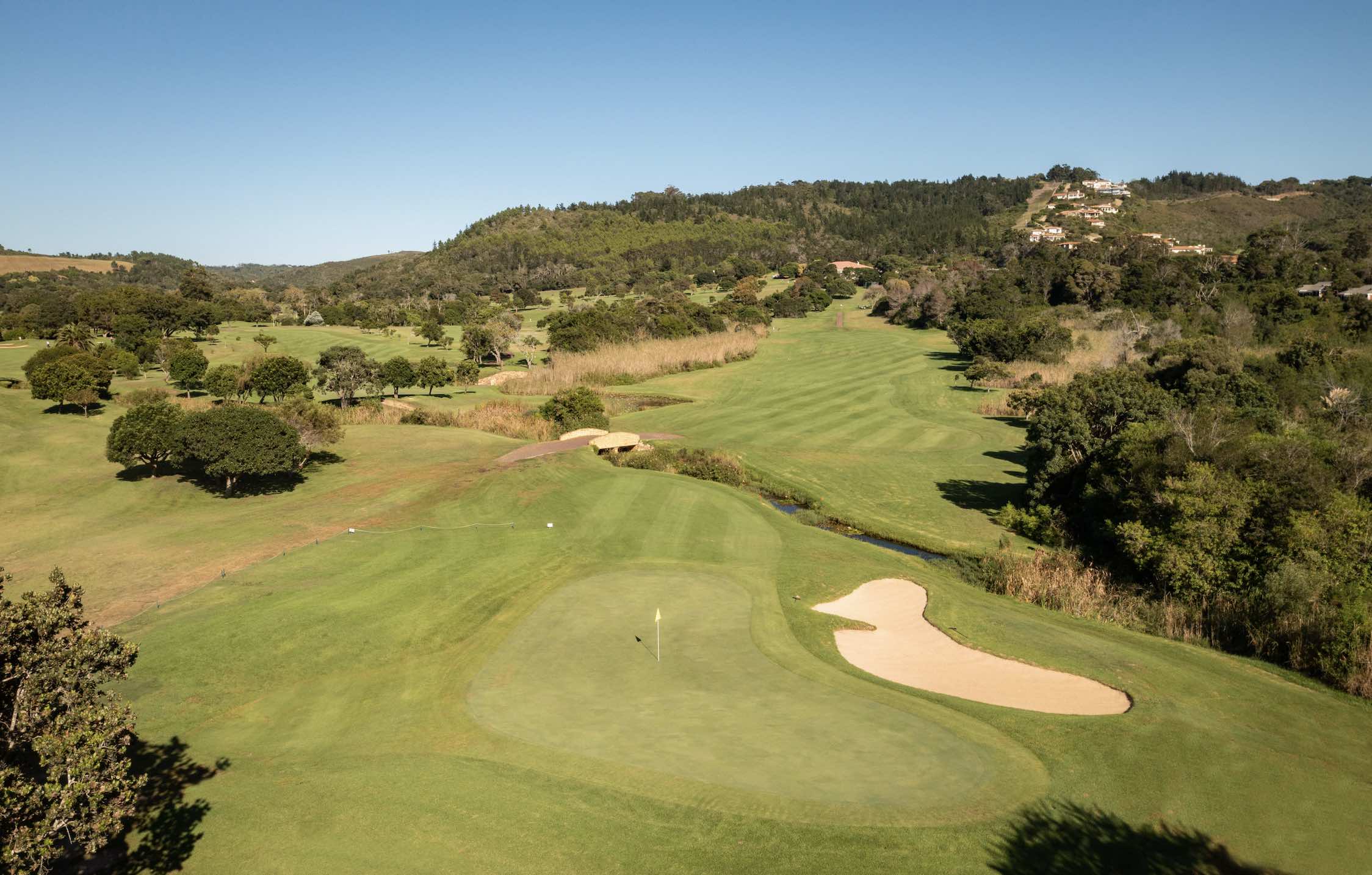
The front nine contains the stroke one which is a devilishly difficult par four of 367m. A creek runs across the fairway and down the right side of it. The average golfer not being able to carry it will have to leave the ball short, resulting in a longer iron to the large green. The green is also protected by two bunkers left and if the westerly wind is up a long-iron, or more, is required to reach it.
The par-five 7th is a taste of what to expect on the back nine. Although very straight, the fairway is protected by large yellowwood trees left and right as well as the Piesang River further right. At 419m it is not long, but the diminutive green is a difficult target with wind swirling around the surrounding trees and the river just right of the surface.
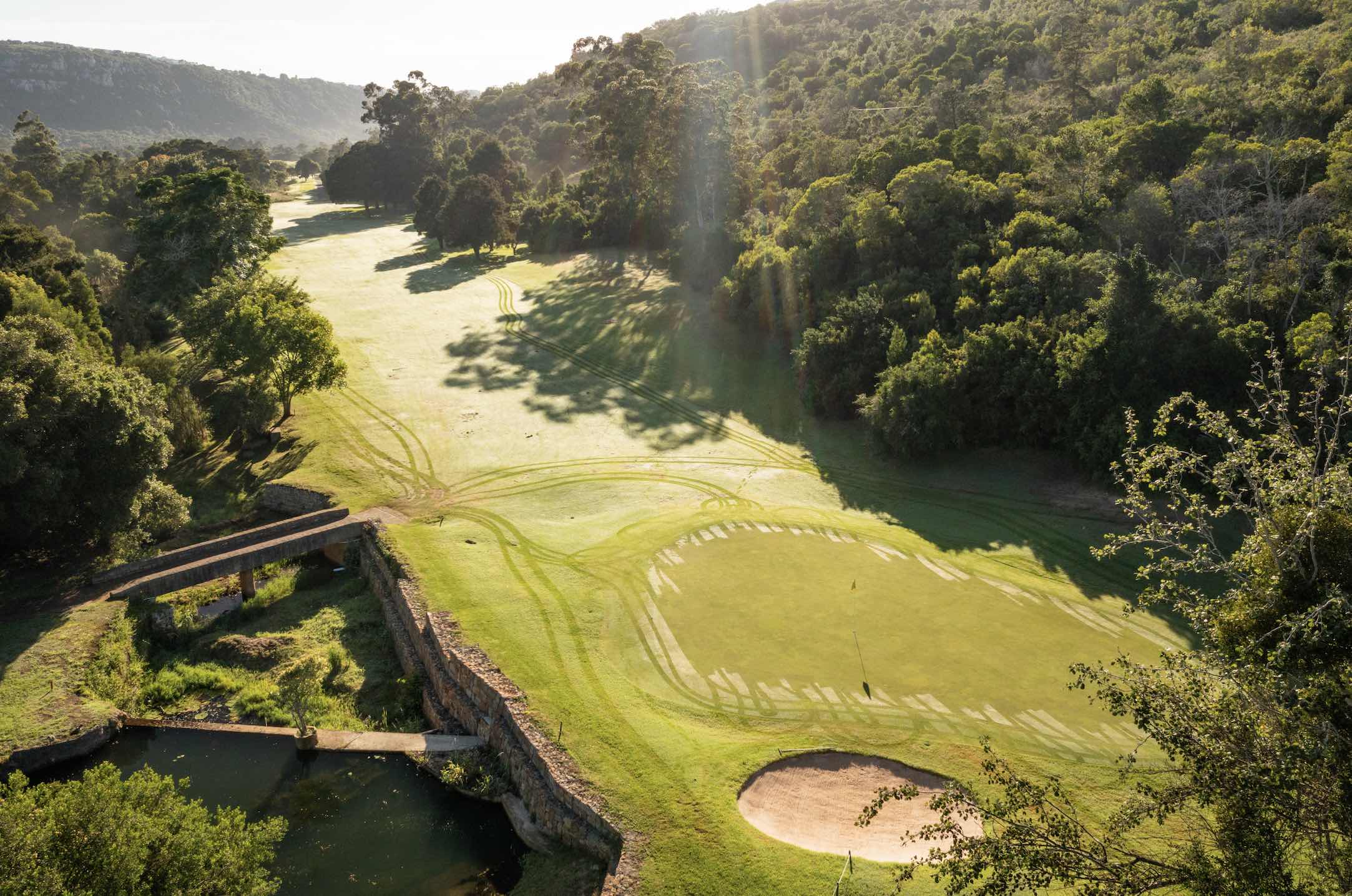
It is tough to pick out specific holes on the back nine as they are all a treat.
The par-four 12th is a phenomenal hole surrounded by yellowwood trees and bush on the left and water on the right. The narrow playing corridor requires an accurate tee shot that then opens up to a lengthy second shot into the green.
The par-four 14th used to be a strong contender for the signature hole with two large oaks towering in the middle of the fairway, making it a tricky 299m hole.
Unfortunately, both trees succumbed to the dreaded borer beetle infestation in 2021. The signature hole status is now owned by the 16th (see below).
The closing hole at Plettenberg Bay Country Club is a strong par five rising towards the clubhouse. The 465m dogleg left tees off with the protection of the trees before the wide fairway can be found. The elbow of the dogleg needs to be reached in order to have a line to the green. Its two-tiered surface is protected by a small pot bunker left and two bunkers right, so having a go for it in two comes with some real danger. It might secure birdies for the longer hitters but you can be sure to get some banter from the patio on competition days.
At first glance, the course seems relatively straightforward. This is not the case and accuracy off the tees, especially on the back nine, is imperative. Impenetrable bush protects many holes with any wayward shots resulting in a lost ball. Most of the holes also have greenside water hazards or the Piesang River encroaching on some part of the hole. Scoring is not that easy which can be seen by club champs and tournament scoring.
This year’s club champion, James Faber, won the two-round tournament with 151 shots and the runner-up, Vincent Windvogel, was six shots adrift. During the mid-amateur champs in 2018 Louis Moolman set a course record of 63 but could not break par on the subsequent three rounds.
It is, however, an incredibly enjoyable round and experience. It is one of the few genuine members clubs along the Garden Route and with that comes a sincere and enjoyable homely feel.
SIGNATURE HOLE
16th hole, par four, 325m
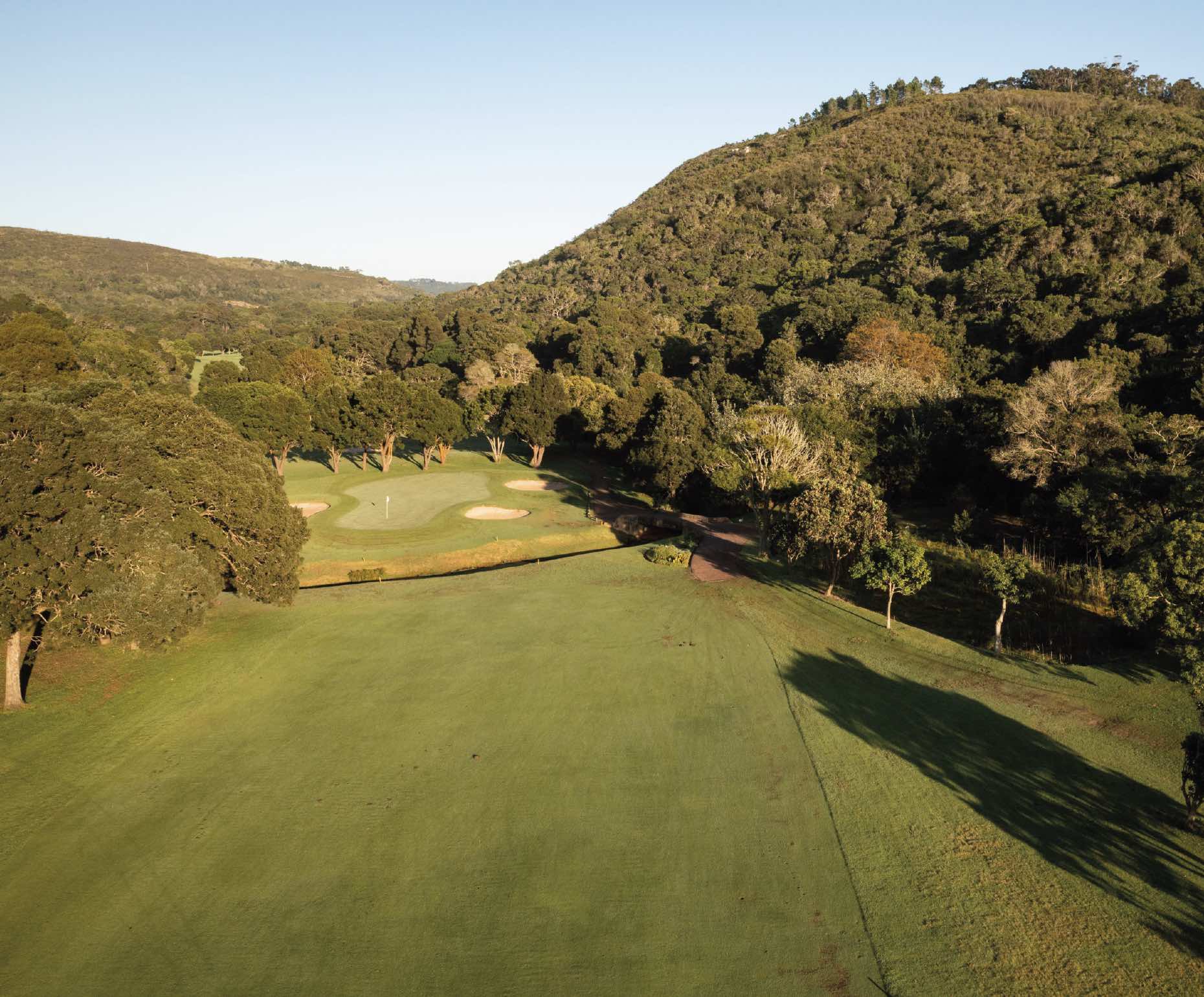
The 16th lies in the centre of the back nine surrounded by bush and towering yellowwood trees.
At 325m it is not long but its clever design by course architect Fred Hawtree brings course management to the fore. Off the elevated back tee, however, it can be a huge challenge to find the fairway even though it is straight.
The tee also offers a great view of the course, but the downside is the added elevation allows the predominant wind to have more influence on ball flight, so be sure to take that into account.
The fairway widens the closer you get to the green but at about 20m out the Piesang River crosses the front of the green, so a well-flighted approach is needed. A large yellowwood encroaches on the left corner of the hole, so the right half of the fairway should be favoured off the tee.
Three bunkers protect the green with one left and two right at the front pinching into the surface, making for a narrow target. Further back, the green area increases and should be the target for the average golfer.
A driver is not necessary off the tee, due to the length of the hole, so keeping it in play and finding the fairway should take priority. A well-struck tee shot will leave anything from 140m to 100m out.
The approach brings all sorts of trouble into play and anything short is in the hazard. Adding a few metres to your approach brings the larger part of the green into play and reduces any chances of the dreaded double going on to the card.
The putting surface has some severe slopes from back to front as well as a ridge that runs across the centre from left to right. Aiming for the middle of the green and going for a solid two- putt is the safer option when tackling this hole.
The shape and sloping of the green are very much part of the reason for its stroke-two rating.
GREENFEES
Visitor greenfees: R600
Carts: R350
GETTING THERE
From the Knysna side, coming in on the N2, there is a sign pointing to Piesang Valley. Turn right and follow the road for about 1.5km and turn right. Follow the signs to the clubhouse. From the Port Elizabeth side, staying on the N2, you will pass through Plettenberg Bay. There is only one traffic circle as you leave Plettenberg Bay. About 300m further on you see the sign to Piesang Valley.
ROAD DISTANCES
Durban: 1,140km
Johannesburg: 1,140km
Bloemfontein: 745km
Cape Town: 520km
Gqeberha: 230km
ADDRESS
Piesang Valley Road, Plettenberg Bay, 6600
CONTACT DETAILS
Pro Shop: 044 533 2132
Email: [email protected]
Website: plettcountryclub.co.za
– This article first appeared in the May 2023 issue of Compleat Golfer magazine.


